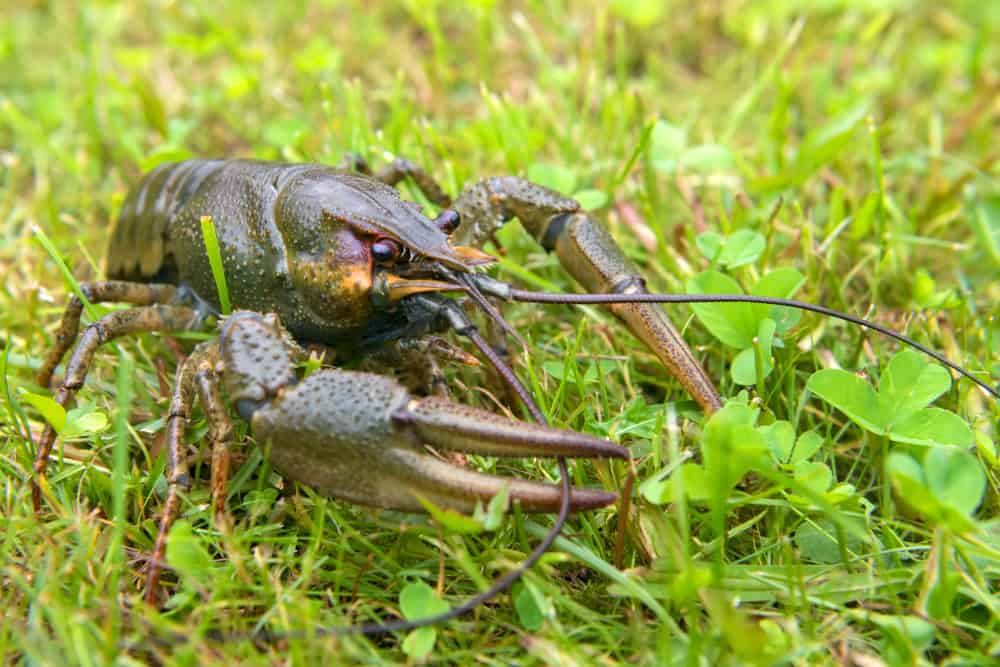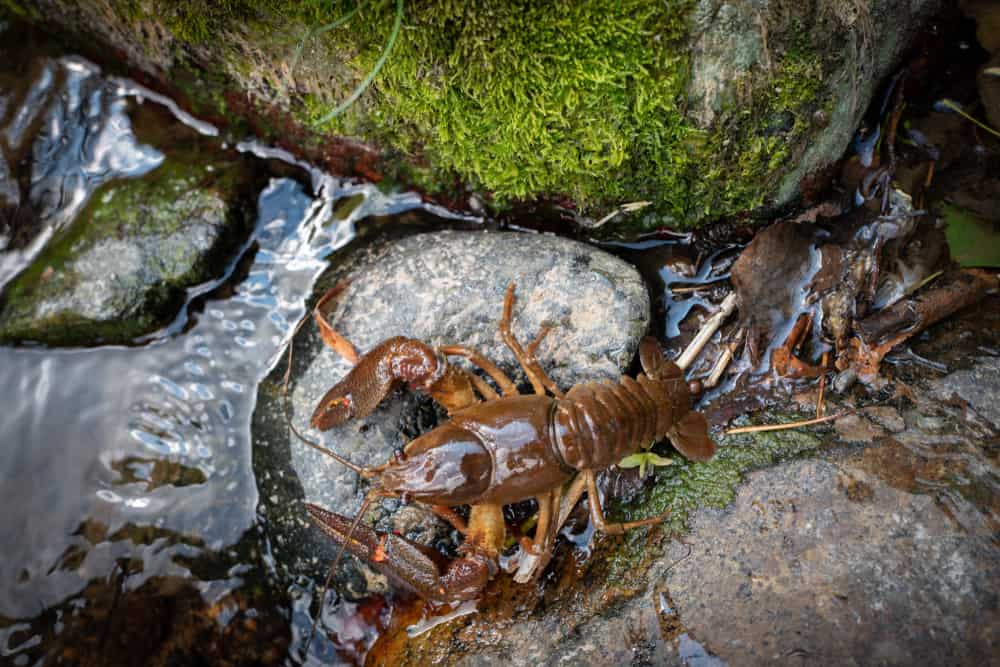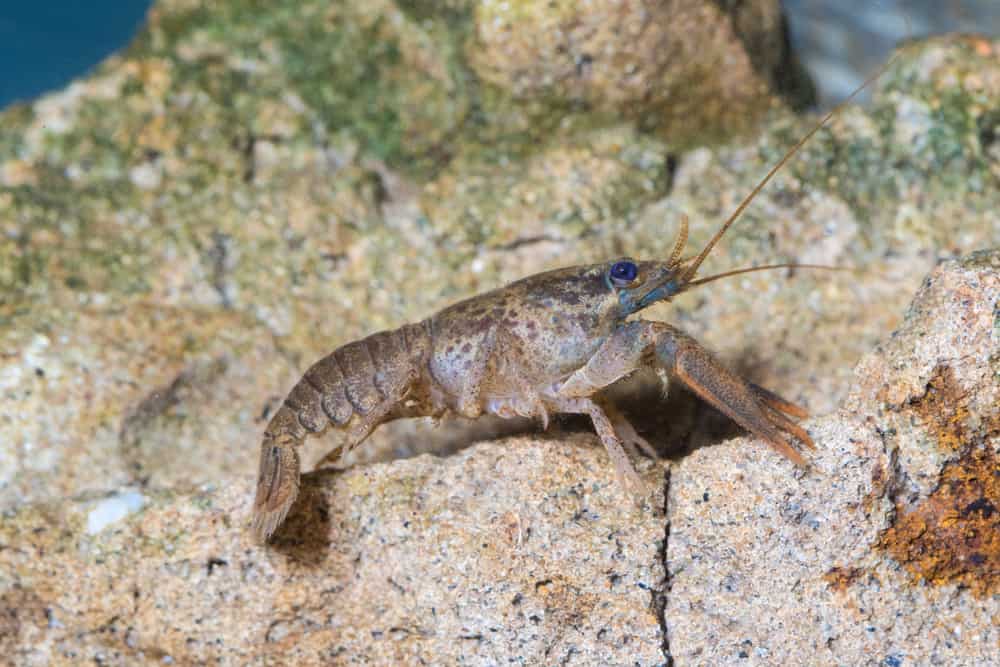Crayfish are aquatic animals that look like lobsters but are smaller. Most people are accustomed to seeing them on their plates or restaurant menus. Have you ever wondered what lies on the crayfish menu?
What do crayfish eat? Read on to quench your curiosity.
Crayfish Habits And Biology
Crayfish, also known as mudbugs, freshwater lobsters, yabbies, crawdaddies, crawfish, among other names, are freshwater crustaceans (e.g.crabs, krills, shrimp) that are similar to lobsters.
The head of the crayfish has a pointed snout and compound eyes for overall vision. A thin but tough exoskeleton covers their bodies.
Adult crayfish can range anywhere from 2.5 centimeters to 7.5 centimeters in length, depending on the species. The largest crayfish species is the Astacopsis gouldi. This crayfish may reach lengths of up to 40 centimeters and weigh 3.5 kilograms.
They have 5 pairs of legs, of which the foremost pair have powerful pincers (chelae). The other pairs of legs are smaller and primarily used for swimming and circulating air for breathing.
They can be found in freshwater streams, whereas others prosper in paddy fields(flooded areas used for growing semiaquatic crops like rice), ditches, and swamps.
Crayfish breathe through their gills. They typically can’t tolerate polluted water. However, some species, such as the Plocambarus clarkii, have adapted to living in polluted waters.
There are over 500 species of crayfish worldwide, most of which live in freshwater bodies of North America. A few species dwell in saltwater, otherwise known as brackish water.
You’ll find them in streams and lakes where they hide under rocks. They are nocturnal and therefore are primarily active at night.
Crayfish will mate in autumn and lay eggs in spring. The eggs hatch in 5-8 weeks. Their larvae will remain with their mother for several weeks. Sexual maturity in some species is reached in a few months, while it may take several years in others.
The lifespan of crayfish ranges from 1-20 years, depending on the species.
What Do Crayfish Eat In The Wild?
Crayfish, like most crustaceans, are omnivorous, and they will eat both plant and animal matter. They will consume almost everything they come across. Their diets consist mainly of dead decaying matter as it is the most accessible source of food.
They will latch on to any dead animal or plants swept downstream by fast currents. By the time it reaches the crayfish, the food material is easy to break apart and eat.
Some of the foods they eat in the wild include:
- Decomposing matter –such as dead animals, for example, a dead fish.
- Decaying vegetation –rotting plant matter can serve as treats for crays as they’re easily torn apart and eaten.
- Algae
- Worms –e.g., earthworms and bloodworms.
- Insects –like flies, mosquitoes, and dragonflies.
- Insect larvae.
- Amphibian tadpoles –such as frogs or salamanders, are hunted by crayfish.
- Shrimp
- Plankton
- Vegetation– for example, grass, weed, and tree leaves.
- In times where food is lacking, crayfish have cannibalistic tendencies and might one another.
It is difficult for crayfish to capture live fish in the wild. Fish are faster and better swimmers than crayfish and can easily escape them in open streams or lakes.
Because crayfish are not the best of swimmers, the food they eat must sink to the river floor before eating it. This limits their choice of foods to eat. However, lots of things end up in the lake and stream floors that crayfish will eat.
Crayfish are nocturnal and mainly carry out their feeding activities under cover of night. They will scavenge for whatever food is available to eat.
What Do Crayfish Eat As Pets?
Your crayfish’s tank environment needs to be similar to that of their environment in the wild. By doing so, you help your crayfish avoid anxiety.
As previously mentioned, crayfish will eat just about anything and therefore are easy to feed. Below are examples of foods you can provide your pet crayfish:
- Sinkable pellets –include algae, kelp, and shrimp pellets.
- Vegetables –like frozen peas, zucchini, carrot chunks, java moss, and broccoli stems.
- Algae wafers –are special biscuits fed to aquatic pets.
- Fruit –bananas, grapes, and apples are some fruits crays will eat.
- Live and dead fish.
- Aquarium plants –like guppy grass, densa, camboba, and hornwort are perfect for feeding crays as they last long. An added advantage is that they are affordable.
- Meat–crays will eat anything from poultry, fish, beef, lamb, you name it!
- Crays can eat mosquito and other insect larvae.
- Fish foods –can easily make up a balanced diet for crays. Feed to them in small amounts to prevent wastage.
- Krill –are small crustaceans that crays enjoy eating. They serve as a ready source of protein.
- Snails
Feeding your crayfish using tongs helps them get used to people and their new environment.
Live food like small fish makes feeding time more exciting as they have to hunt for their food actively. You can feed your leftover veggies from a meal to your crayfish to avoid wastage of food.
Leafy greens such as kales and spinach are easy for them to tear apart with their claws.
Crayfish will also help keep their tanks clean through their feeding habits. They will feed on algal or bacterial blooms that occur in the tank.
Algal and bacterial bloom refers to the rapid increase in the number of algae or bacteria in freshwater.
It is not uncommon for crayfish to spend a better part of their days in their hideouts. Establishing a regular feeding routine will encourage them to come out more to feed.
If you don’t feed your crayfish enough, they may become cannibalistic and attack one another if two or more crays occupy the same tank.
Tips To Feeding Crayfish
Crayfish make lovely pets. Very little is required to raise them. The most important thing is to raise them is a spacious tank/aquarium to roam freely. Feeding them is a simple task as they aren’t picky eaters.
To effectively care for and ensure that your crayfish stays healthy, here are some tips to consider:
Prepare a tank to house your crayfish.
- Ensure your tank has an air bubbler; crayfish may drown if submerged in water for long periods without a separate source of oxygen.
- Crayfish prosper in cool conditions and therefore don’t purchase a heated tank.
Fill the tank with freshwater.
- Setting your tank up indoors will help maintain constant temperatures for your crayfish. Consistent temperatures help them thrive, be healthy and active.
Regularly change the water in your tank.
- You should perform this practice at least once every week as crayfish generate large amounts of waste products.
- If your tank lacks a filter, changing the water twice a week would be more effective in maintaining a clean environment for your crayfish.
Provide your crayfish with shrimp pellets once a day.
- Pellet foods are rich in protein and other nutrients that help in the development of healthy shells.
- You can also feed them frozen aquarium foods like bloodworms, brine shrimp, and daphnia.
- Avoid feeding your crayfish live uncooked shrimp as they are carriers of diseases fatal to them.
Supplement your crays diet with veggies.
- Occasionally cut some cabbage, cucumber, or zucchini into small pieces and let them sink to the bottom of the tank.
- Crayfish will gladly eat spoiled or decaying matter, so don’t throw away those rotting bits of food!
Don’t overfeed your crayfish.
- Remove any uneaten portions of food from your crays tank to prevent it from decomposing and dirtying the tank water.
- When crayfish overeat, their exoskeletons become soft and weak.
Ensure your crayfish is safe from other fish that may occupy the tank.
- Though crayfish don’t pose a threat, fish like catfish are known to attack them. This, in turn, may lead to injury or death of one or both animals.
- Avoid keeping more than one crayfish in one tank. Different species of crayfish in the same tank are likely to attack and kill one another.
You should provide your crayfish with the best conditions for molting.
- Once every few months, your crayfish will shed its exoskeleton to accommodate its growing body.
- Don’t remove its exoskeleton from the tank once shed, as it will feed on it for nutrients required to grow a new one.
- Avoid feeding it for the first few days after it molts.
- To prevent your crayfish from succumbing to iodine deficiency after molting, add a few drops of potassium iodide into their water.
Lastly, keep your tank covered to prevent your crayfish from getting out. Crayfish are natural explorers by nature and won’t miss out on an opportunity to explore beyond their horizon.
Frequently Asked Questions (FAQs)
How long can a crayfish live above water?
Crayfish will survive outside water for several days only. They will have to find a freshwater water source to wet their gills. Otherwise, they might end up dying.
Do crayfish eat poop?
Despite crayfish tendencies to eat almost everything, they don’t benefit from feeding on poop belonging to them or other animals.
How long can a crayfish do without food?
Crayfish can go without food for about a week. In cases where you have to travel for short periods, ensure you feed them beforehand. Also, it’s essential to have recently cleaned your tank to prevent dirt build-up while you are away.
Summary
Knowing ‘what do crayfish eat?’ is vital when it comes to keeping them as pets. They make fantastic pets as they require minimum attention, making them easy to look after.
The fact that they eat practically anything you offer them is an added advantage.



very informative thanks